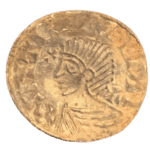
The fall of the Western Roman Empire in 476 CE marked a significant transition in the economic systems of Europe and the Mediterranean world. Among the numerous legacies of the Roman Empire, one of the most enduring was its monetary system, particularly the use of the gold solidus. Introduced by Emperor Constantine the Great in 312 CE, the solidus became the backbone of Byzantine and barbarian economies in the centuries that followed, demonstrating remarkable stability and influence during a time of upheaval.
Origins and Characteristics of the Gold Solidus

The gold solidus was a high-purity gold coin, weighing approximately 4.5 grams, and introduced as part of Constantine’s economic reforms to stabilize the Roman currency system. Its purity and consistent weight were central to its success, earning it widespread acceptance across the Roman Empire and beyond. Unlike earlier Roman coins, which suffered from debasement and fluctuating value, the solidus maintained its integrity for centuries, becoming a trusted medium of exchange.
The coin bore an image of the emperor on one side and often depicted religious or imperial motifs on the reverse, reinforcing its role as a symbol of both economic stability and imperial authority. By tying the coin’s value to a reliable weight of gold, the solidus inspired confidence among merchants, soldiers, and tax collectors alike.
The Solidus in the Byzantine Economy
After the fall of the Western Roman Empire, the Eastern Roman Empire, or Byzantine Empire, emerged as the primary guardian of Roman traditions, including its monetary system. The solidus, renamed the nomisma in Byzantine usage, became the foundation of the Byzantine economy. Its stability and reliability allowed the empire to maintain a robust economic system, even as neighboring regions faced fragmentation and decline.
The Byzantine state used the solidus to pay its armies, fund public works, and conduct diplomacy. The coin also served as a key instrument of imperial propaganda, spreading the image and authority of the emperor across vast distances. Byzantium’s control over gold resources, primarily from mines in Anatolia and the Balkans, ensured a steady supply of solidi, which were meticulously minted under strict state supervision.
Byzantine solidi were highly sought after in international trade. Merchants from Western Europe, the Islamic world, and beyond prized the coin for its gold content and consistent weight, often using it in transactions involving luxury goods such as silk, spices, and precious metals. The solidus became a de facto international currency, underpinning the Byzantine Empire’s economic interactions with neighboring powers.
The Solidus in Barbarian Economies

As the Western Roman Empire disintegrated, its former territories were divided among various barbarian kingdoms, including the Visigoths, Ostrogoths, Vandals, Lombards, and Franks. These kingdoms inherited a world where Roman economic systems, infrastructure, and cultural practices still exerted considerable influence. The solidus played a key role in bridging the Roman past with the new barbarian order.
Barbarian rulers quickly recognized the value of the solidus as a medium of exchange and a symbol of authority. Many kingdoms began minting their own coins modeled on the Byzantine solidus, often featuring local rulers in place of the Byzantine emperor. This adaptation reflected a blend of Roman traditions with emerging barbarian identities, as coins served both economic and symbolic purposes.
For example, the Visigothic Kingdom in Hispania minted gold tremisses, a smaller denomination derived from the solidus, to facilitate trade and taxation. Similarly, the Lombards in Italy issued coins that retained the solidus’ basic design while incorporating Lombardic motifs. These adaptations underscored the enduring prestige of the Roman monetary system, even as political control shifted to barbarian hands.
The Solidus and Trade
The solidus facilitated trade between barbarian kingdoms, the Byzantine Empire, and other regions. It was particularly valuable in transactions involving luxury goods, such as jewelry, fine textiles, and imported spices. In some cases, barbarian rulers used the solidus to pay mercenaries or as tribute to neighboring powers, underscoring its role as a universally recognized currency.
The coin’s reliability also helped sustain trade networks that had originated during the Roman Empire. These networks extended from the Mediterranean to northern Europe, enabling the exchange of goods and ideas. The presence of Byzantine solidi in archaeological sites across Europe testifies to the coin’s widespread circulation and its importance in maintaining economic connections during a time of political fragmentation.
Prestige and Power
For barbarian rulers, the solidus was more than just a currency; it was a symbol of legitimacy and continuity with the Roman past. By issuing coins in the style of the solidus, these rulers aligned themselves with the authority and prestige of the Roman Empire. This connection was particularly important in a world where Roman cultural and political norms still held significant sway.
In addition to its symbolic value, the solidus provided a practical means of consolidating power. Barbarian kings used the coin to pay their retainers, fund construction projects, and distribute wealth to loyal supporters. By controlling access to gold and the ability to mint coins, rulers reinforced their authority and fostered economic stability within their realms.
Decline and Transformation
Despite its remarkable resilience, the use of the solidus as a currency began to decline in the later part of the 6th century and beyond. Several factors contributed to this trend, including the depletion of gold resources, the rise of local currencies, and the shifting dynamics of trade and power.
Byzantine gold mines faced increasing challenges as deposits became harder to exploit. This scarcity of gold limited the production of solidi, forcing the Byzantine Empire to debase its coinage in later centuries. While the solidus remained a valuable currency, its diminished availability reduced its prominence in everyday transactions.
As barbarian kingdoms matured, many developed their own distinct monetary systems. These systems often relied on silver or other metals, reflecting the resources available in different regions. The shift to local currencies marked the gradual transition from a Roman-dominated economic system to a more diverse and decentralized landscape.
The decline of the solidus also coincided with changes in trade patterns across Europe and the Mediterranean. The rise of Islamic caliphates, the expansion of the Frankish Empire, and the increasing importance of northern Europe’s economy reshaped the flow of goods and wealth. While the solidus continued to circulate, it was increasingly supplemented or replaced by other forms of currency.
Legacy of the Solidus
The gold solidus left a lasting legacy in the history of European and Mediterranean economies. Its introduction by Constantine the Great established a standard of monetary stability that endured for centuries, even in the face of political turmoil. The coin’s role as a trusted medium of exchange and a symbol of imperial authority bridged the Roman and post-Roman worlds, influencing economic practices across diverse regions.
The solidus also set a precedent for the use of high-value gold currency, inspiring later monetary systems in Europe and beyond. The Byzantine Empire’s commitment to maintaining the solidus as a stable currency reinforced its reputation as a center of economic and cultural power. Meanwhile, barbarian adaptations of the coin demonstrated the enduring influence of Roman traditions in shaping new political and economic orders.
In many ways, the story of the gold solidus reflects the resilience and adaptability of Roman institutions in the face of profound change. Even as the Western Roman Empire crumbled, the solidus continued to circulate, connecting diverse communities and sustaining economic activity across a fragmented world. Its legacy serves as a testament to the enduring power of trust, stability, and innovation in the realm of currency.




